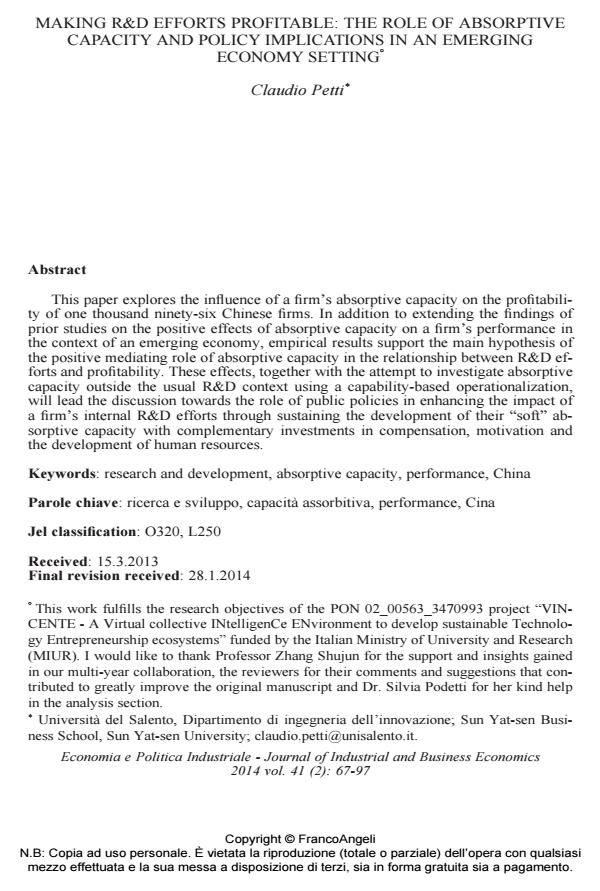Making R&D efforts profitable: the role of absorptive capacity and policy implications in an emerging economy setting
Journal title ECONOMIA E POLITICA INDUSTRIALE
Author/s Claudio Petti
Publishing Year 2014 Issue 2014/2
Language English Pages 31 P. 67-97 File size 131 KB
DOI 10.3280/POLI2014-002004
DOI is like a bar code for intellectual property: to have more infomation
click here
Below, you can see the article first page
If you want to buy this article in PDF format, you can do it, following the instructions to buy download credits

FrancoAngeli is member of Publishers International Linking Association, Inc (PILA), a not-for-profit association which run the CrossRef service enabling links to and from online scholarly content.
This paper explores the influence of a firm’s absorptive capacity on the profitability of one thousand ninety-six Chinese firms. In addition to extending the findings of prior studies on the positive effects of absorptive capacity on a firm’s performance in the context of an emerging economy, empirical results support the main hypothesis of the positive mediating role of absorptive capacity in the relationship between R&D efforts and profitability. These effects, together with the attempt to investigate absorptive capacity outside the usual R&D context using a capability-based operationalization, will lead the discussion towards the role of public policies in enhancing the impact of a firm’s internal R&D efforts through sustaining the development of their "soft" absorptive capacity with complementary investments in compensation, motivation and the development of human resources.
Keywords: Research and development, absorptive capacity, performance, China
Jel codes: O320, L250
- Green supply chain collaborative innovation, absorptive capacity and innovation performance: Evidence from China Jiangtao Hong, Ruyin Zheng, Hepu Deng, Yinglei Zhou, in Journal of Cleaner Production 118377/2019 pp.118377
DOI: 10.1016/j.jclepro.2019.118377 - Government Support and R&D Investment Effectiveness in Chinese SMEs: A Complex Relationship Claudio Petti, Lauretta Rubini, Silvia Podetti, in Asian Economic Papers /2017 pp.201
DOI: 10.1162/ASEP_a_00504
Claudio Petti, Making R&D efforts profitable: the role of absorptive capacity and policy implications in an emerging economy setting in "ECONOMIA E POLITICA INDUSTRIALE " 2/2014, pp 67-97, DOI: 10.3280/POLI2014-002004